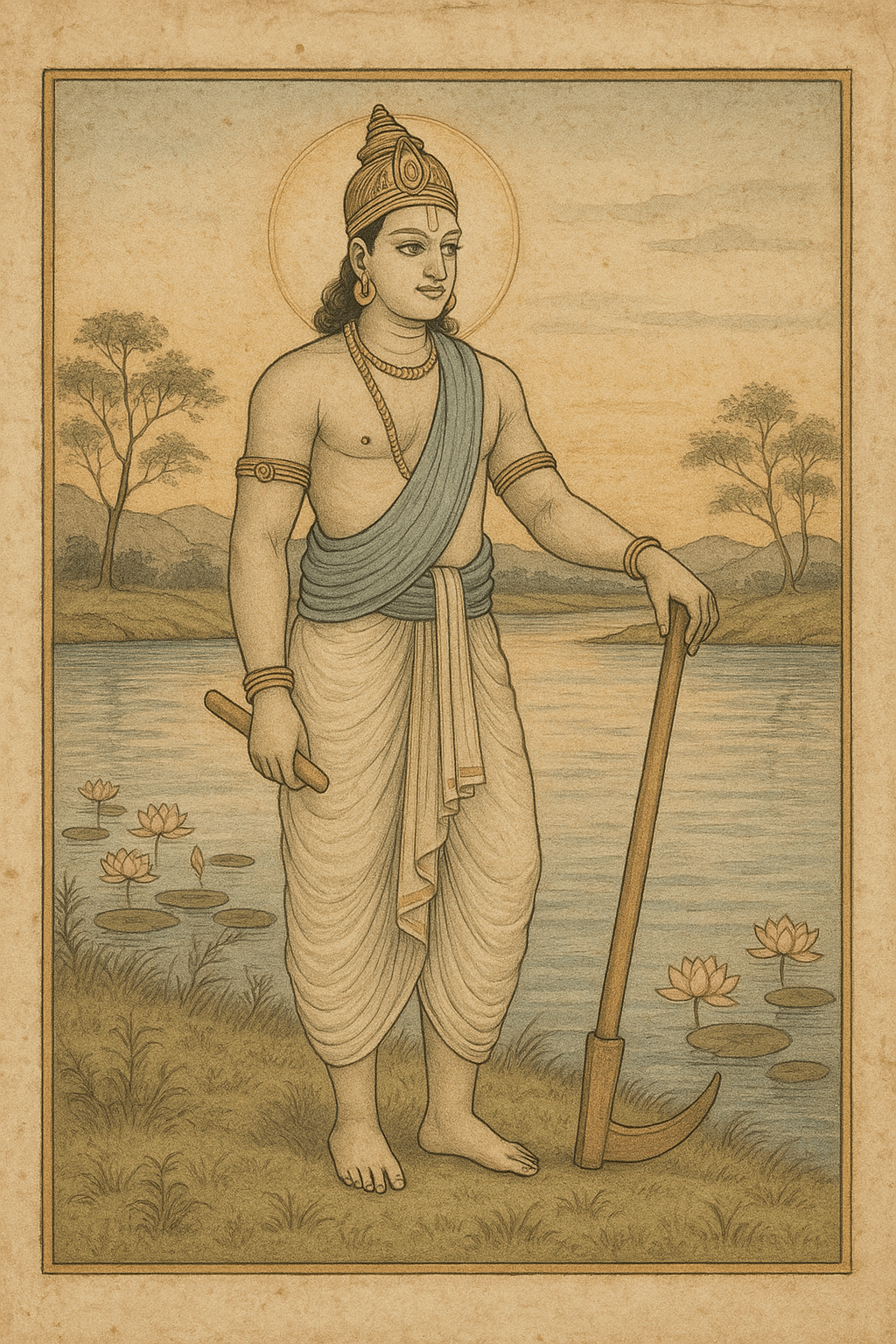Saraswatha Parva is the seventy-sixth Upa Parva included in the ninth Maha Parva named as Shalya Parva. Vaishampayana continued narration to Janamejaya in reply to his queries as follows.
Balarama had gone for pilgrimage. He started it before the start of the war. Balarama had advised Krishna to be impartial during the war but Krishna replied he would be aligned to the side of Dharma. Duryodhana had studied mace fight under Balarama along with Bhima.
During the pilgrimage, Balarama had visited the twelve Shiva kshetras and fifty two Devi kshetras. Balarama desired Dwaraka would be one such notified holy place similar to the well-known seven pilgrimage centers. So Balarama decided to return to Dwaraka finally calling Krishna from Kurukshetra, and travelled together.

After the sinking of Dwaraka island, a temple for Krishna was built at Puri. So Puri is similar or equivalent to Dwaraka in holiness. Separate deities for Subhadra and Balabhadra were also available with Krishna in Puri. In the Tirthayatra parva, more description about the holy places and rivers would be available. Balarama desired for a peaceful life and hence kept away from the war hoax.
Why this Upaparva got its name as Saraswatha parva?
Saraswathi was a great holy river. The river banks consisted of many holy places and many Rishis. They were living in their hermits there. Balarama had visited almost all such places and Vyasa had given the detailed descriptions of them with many side stories. Hence this Upa parva got its name as Saraswatha parva.
In addition to the monitoring of the progress of the war, Balarama wished to see the success of the mace fight between Duryodhana and Bhima. This Upa parva contained many side stories related to the holiness of the river. Some of the side stories or Upakhyanas were about Rishis like Vishwamitra, Vasishta, old Dritarashtra’s donations to Baka Muni, marriage of Chandra or Soma, the twenty seven wives of Chandra and so on.
When Pandavas sent signals, i.e., sounds of arriving near the water tank, what did the trio do?
The trio, Kripa, Kritavarma and Ashvathama had ascended their horses and disappeared into the forests when Pandavas made sounds of arriving there. Ashvathama had anticipated his arrest by Bhima so they took their heels quickly. But Bhima had captured Asvasthama later and he had left to Badarikashrama.
Duryodhana was ready for the mace fight, but who arrived then and there?
When Duryodhana was ready for the mace fight, Balarama had arrived there in the early morning. He was a peace lover. He had gone for pilgrimage for the last forty two days. He was the elder brother of Krishna. He had not participated in the war. He had visited many holy places like Prabhasa Kshetra, situated on the banks of Saraswathi River. He had come there to see his disciples’ mace fight.
How did Balarama arrange for his pilgrimage?
Balarama had sent his servants to Dwaraka and procured sufficient materials for his pilgrimage. He led a holy life. He donated many items for the deserved persons.
How did Vaishampayana explain about the holy Saraswathi River?
Saraswathi River was very holy in Dwapara yuga. The surface water was considered as good and holy, and many Rishis’ hermits were there like temples.
What is Sapta Saraswata?
There were seven tributaries to the main River. They were the Sapta Saraswathas.
What happened to the son of Gadhi, named as Vishwamithra?
The son of Gadhi, king Vishwamitra desired to become a Brahmin. He was competing with Vasishtha. The river Saraswathi had brought the hermit of Vasishtha by the flood water, by force and order of Vishwamitra. Vishwamitra had shown his power of penance. But Vasishtha was calm and quiet.
Later, Vishwamitra also reached a stage of Brahma Rishi by means of penance. He created a heaven for the king Trishanku to show his power of penance.
Why did Muni Baka punish Dritarashtra?
Dritarashtra had donated week male calves to Muni Baka but good cows were preserved by him for his use. It was an old, different Dritarashtra, a king of Panchala.
After many years, that Dritarashtra faced famine in his kingdom. After twelve years, when there was no sufficient water even for drinking, Dritarashtra had consulted an Astrologer for the reasons for the bad times faced by him.
The Astrologer advised to donate good cows to Muni Baka to satisfy him on the banks of Saraswathi river. After doing so, the status of his kingdom had financially improved. The greedy human beings were changed as generous by this river.
What was Oghavathy?
The seven tributaries of the Saraswathi river were called as Saptha Saraswathas. Oghavathy was one of them.
Why Saraswata Muni ate fish?
Saraswata Muni was living on the banks of Saraswathi River in his hermit. Due to famine, people were suffering for many years and migrated to safer city places but Saraswata Muni treated Saraswathi river with reverence. The river provided him fish each day just for his life. He was eating fish and doing penance there.
Later, rain had poured there and the area had flourished with grains. Saraswata Muni then led a vegetarian life. He preserved Vedas and taught many disciples; later his disciples had propagated Sanatana Dharma. Saraswata Muni was a permanent reciter of the principle “Keep body live to retain Dharma”, i.e., शरीरमाद्यं खलु धर्म साधनं.
How did Balarama spend his time during the Mahabharata war?
Daily, Balarama was visiting holy places and taking bath in holy rivers. He was donating money, clothes and food for the deserving people. He was the king of Dwaraka. He also had servants including army intelligence. They were arranging for his routine travel and halt at night. Finally, he reached Kurukshetra.
What did Narada had advise Balarama?
Narada had advised Balarama to see the mace fight between Duryodhana and Bhima. He could directly see by visiting Kurukshetra and he could return to Dwaraka later. Narada knew Balarama was the teacher of those mace fighters.
What did Balarama finally decide after forty two days?
Balarama had decided to visit Samanta Panchaka area of Kurukshetra finally.
Next post, Mahabharat: Gadayuddha Parva would be more interesting.
Mahabharat: Sauptika Parva would be presented separately in another article.
What are the benefits of reading this story?
On reading this story, children would gain more memory power, great moral strength in their lives in future; creating a sense of self-reliance, leading to peace and progress.
It is humbly prayed for the blessings of God Krishna upon us.
Readers may share this story with children, friends and family.

Leave a Reply